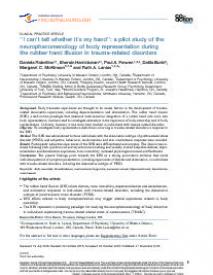“I can’t tell whether it’s my hand” : a pilot study of the neurophenomenology of body representation during the rubber hand illusion in trauma-related disorders
Background: Early traumatic experiences are thought to be causal factors in the development of trauma-related dissociative experiences, including depersonalization and derealization. The rubber hand illusion (RHI), a well-known paradigm that measures multi-sensorial integration of a rubber hand into one’s own body representation, has been used to investigate alterations in the experience of body ownership and of body representation. Critically, however, it has never been studied in individuals with trauma-related disorders.
Objective: To investigate body representation distortions occurring in trauma-related disorders in response to the RHI.
Method: The RHI was administered to three individuals with the dissociative subtype of posttraumatic stress disorder (PTSD), and subjective, behavioral, cardiovascular and skin conductance responses were recorded.
Results: Participants’ subjective experiences of the RHI were differentiated and complex. The illusion was induced following both synchronous and asynchronous brushing and variably evoked subjective distress, depersonalization and derealization experiences, tonic immobility, increased physiological arousal and flashbacks.
Conclusions: The present findings point towards the RHI as a strong provocation stimulus that elicits individual patterns of symptom presentation, including experiences of distress and dissociation, in individuals with trauma-related disorders, including the dissociative subtype of PTSD.
In: European journal of psychotraumatology, ISSN 2000-8066 | 7 | [1] | 32918
http://dx.doi.org/10.3402/ejpt.v7.32918


